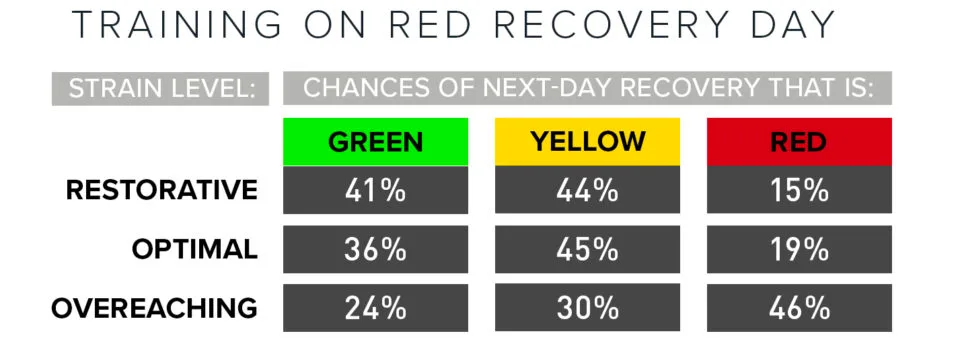Topics
- Article
- Recovery
- Training & Exercise
Feels vs Facts: Why You Still Need a Rest Day, Even When You're Feeling Good

The most important training days of the week may be the ones when you rest and recover.
"Feels vs Facts" is a content series exploring the common feelings people have during endurance sports and training, and the explanation behind what's actually happening to your body. The purpose is to help you better understand these feelings by grounding them in science. Imagine this: You’re training hard each day, and you feel like you should keep going. That’s what it takes, right? But even though you feel ready to go, your coach is telling you to take a day off. Why? One of our main goals as coaches is to bring the discussion about rest days into alignment with the science of rest days. Athletes often view rest as an empty space, a pause, or even a step back. In reality, consistent rest and recovery days are opportunities to take massive leaps forward, spurring adaptation from the cellular level all the way up to how our nervous systems integrate stresses from training and life. Training without adaptation is breakdown. And much too often, the world of endurance sports sees “strong training” when it’s actually looking at something more like “slow-burn self-destruction.”

Athletes often view rest days as a step back, but In reality they're opportunities to take massive leaps forward.
OK, we know that’s a provocative thing to say, but in coaching athletes from beginners to pros the strongest predictor of long-term growth amongst similarly-situated athletes is an ability to adapt to the work they are doing. What might we be seeing? It’s likely tied to how chronic stress impacts the endocrine system, musculoskeletal system, and nervous system, mixed with individual genetic variation. We’re going to set the stage with some studies before tying all of the science together at the end in some fascinating new WHOOP data.
Effects of Overreaching on the Endocrine System
A 2018 study in the journal Hormones found that male athletes training over seven hours per week had a 10% reduction in testosterone levels after one year of training, and a 30% reduction after five years training. A 2020 study in the International Journal of Environmental Research and Public Health found that in a single season, testosterone levels dropped as volume increased, before rebounding as volume stabilized. Numerous studies have similar findings for male athletes, seeing a relationship between sustained, higher volume training and negative endocrine impacts. The relationship is more difficult to study in female athletes due to the monthly variation in the menstrual cycle, but you could fill a tractor trailer with printed-out studies connecting low energy availability with hormonal disturbances. A 2019 article in the International Journal of Sport Nutrition and Exercise Metabolism described how even small offsets between energy consumption and expenditure can suppress sex hormones, hurt bone density, increase injury rates, and decrease adpation to training. And, energy availability is not just about making sure you get enough over the course of a day. Endocrine system disruptions also result from excessive within-day deficits (2017 study on female athletes; 2018 study on male athletes). Plus, for male and female athletes alike, chronic exposure to stress hormone cortisol can wreak havoc on the endocrine system. Every training day risks turning down the knob on sex hormones, turning up the knob on cortisol, and causing minor offsets in energy availability. Rest days are endocrine system insurance, allowing for glycogen recovery and stabilization of cortisol levels. KEY POINT: Endocrine system stabilization is essential for an athlete to actually adapt to the work they are doing. Keep the pedal to the metal, and the engine will overheat, if the car is lucky enough to not fly off a cliff first.
Overuse Takes Its Toll on the Musculoskeletal System
Most injuries start as very minor changes in soft tissue or bone. At that early stage, it may actually be an adaptation stimulus--take a recovery day, come back stronger. The scary part for any lifelong athlete is that at first you might not even feel it. Being a motivated athlete is sometimes like thinking you’re running on solid ground when you’re actually on a tightrope. From there, injuries progress down the paths we hope you don’t have to get familiar with too often. A few days off becomes a few weeks, you develop a too-close relationship with your local MRI technician, and you might even decide that pursuing your potential is not worth it. Bad knees, tibias that snap, hips that lie. It sucks, and Shakira would be disappointed.

Most injuries start as small changes in soft tissue or bone that progress with overuse.
But in way more cases than athletes sometimes think, it can be preventable. What we see in our team data with planned rest days is that they prevent the accumulation of unplanned rest weeks and months. However, even if you’re a lucky, beautiful genetic outlier that never gets injured, the same rationale is essential for adapting to hard training. Here’s one of our favorite studies of all time. A 2016 case study in the journal Physiology Reports looked at daily measurements of numerous blood counts, including creatine kinase as a proxy for muscle damage. If an athlete showed abnormal deviations, training was reduced. Running economy improved significantly in the athletes that were adding downtime in response to cellular-level processes that they often didn’t even perceive. KEY POINT: Planned rest days may prevent the accumulation of unplanned rest weeks and months, while supporting sustainable adaptation.
Stress and the Nervous System
The hardest part about being an athlete can be understanding how daily perceptions of how you feel actually correspond to what’s happening in the body. While that’s a big problem for hormones and blood counts, it’s especially difficult for the nervous system. In the worst cases, miscalibrated stress monitoring can lead to overtraining syndrome, where the nervous system shuts down and prevents most performance altogether. As a 2014 review in Current Sports Medicine Reports said: “the insidious onset of OTS slowly saps the efficacy of recovery times so the athlete is no longer able to reach previously attainable goals.” It happens gradually, before happening all at once. But long before clinical overtraining, recovery and performance can suffer through overreaching.

WHOOP monitors heart rate variability and uses it to help calculate your daily recovery, a measure of your body's readiness to perform.
Every stress is absorbed and processed by the nervous system. It’s how we get out the door, how we respond to training, and what determines how we adapt. By accurately measuring heart rate variability, WHOOP makes it possible to monitor the nervous system to get some insight into what is actually happening in our bodies. Let’s dive into some incredibly cool WHOOP data.
Impact of a Rest Day on WHOOP Recovery
The information comes from a massive dataset on “red” days from users, when the WHOOP recovery metric indicates that an athlete is not primed for strain, primarily relying on those nervous system variables. The big question: How do training levels on a red day impact WHOOP variables the next day? Members who had restorative (low) strain on a red day were 2.3 times less likely to have another red day than members who overreached (higher strain). Additionally, 85% of members who had restorative strain on a red day avoided a second red day. Meanwhile, overreaching on a red day led to a 46% chance of another red day, and those double-red members had about a one-third chance of backing that up with a third red day after that.

Higher strain on a red day increases the chances of staying in the red the next day, and decreases the likelihood of getting back in the green.
What worries us most is that string of red days that happens with continually training through nervous system signals from WHOOP data. A day here or there where HRV goes down is normal, and likely won’t have a huge impact on adaptation. But stacking those red days up may get risky for long-term health, not just performance. KEY POINT: Overreaching on a red day may be risky for long-term health and performance.
Takeaway
We like athletes to take a full rest day once a week. Unfortunately, we can’t do daily blood tests or salivary hormone measurements. Thankfully, WHOOP helps us see under the hood and understand how the body is actually responding to strain, and our observations overlap with what these data show–if athletes fail to create the context for growth via consistent rest and recovery, all the training in the world can amount to stagnation, regression, or an injury. So be proud of your rest days. Training doesn’t make champions. Recovery makes champions.